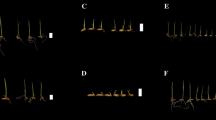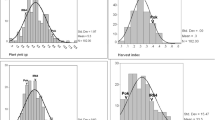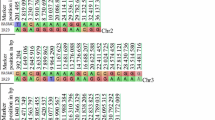Abstract
Improvement in salt tolerance at reproductive stage is very important for enhancing the grain yield and highly desirable to sustain production in saline areas. In the present study, 140 F2 populations derived from PS5, which is saline sensitive and CSR10, saline tolerant rice variety. We evaluated 140 F2 for salinity tolerance at reproductive stage for 18 different morphological, biochemical and physiological traits. We used 436 rice HvSSR markers which covers 12 chromosomes of rice. The linkage map has been created with 100 polymorphic markers and 140 F2 mapping population. We identified 39 QTLs which explained 3–45% phenotypic variance at LOD score 2.6–15.2. Significant QTLs were identified for sodium content, potassium content, sodium/potassium ratio in roots and leaves including qNaL-1.2, qNa/KL-1.3, qKR-1 and qNa/KL-1.2 with R2 of 45%, 42%, 35% and 32%, respectively, on chromosome 1. We identified novel QTL qGY-2 for grain yield on chromosome 2 along with QTL for stress tolerant index on chromosome 6, a noteworthy QTL for salt susceptible index of grain yield was recognized with 45% of phenotypic variation. We also identified four novel QTLs for chlorophyll content and one locus for proline content in leaves under salinity. Validation of these QTLs in fixed mapping population (RILs) and further fine mapping of these QTLs may be advantageous for marker-assisted breeding programs that led to development and commercial cultivation of reproductive stage salt-tolerant rice varieties.


Similar content being viewed by others
References
Ahmadi J, Fotokian MH (2011) Identification and mapping of quantitative trait loci associated with salinity tolerance in rice (Oryza sativa) using SSR markers. Iran J Biotech 9:21–30
Ali S, Gautam RK, Mahajan R, Krishnamurthy SL, Sharma SK, Singh RK et al (2013) Stress indices and selectable traits in SALTOL QTL introgressed rice genotypes for reproductive stage tolerance to Sodicity and salinity stresses. Field Crops Res 154:65–73
Ammar MHM, Pandit A, Singh RK, Sameena S, Chauhan MS, Singh AK (2009) Mapping of QTLs controlling Na+, K+ and Cl− ion concentrations in salt tolerant indica rice variety CSR 27. J Plant Biochem Biotech 18:139–150
Azooz M, Shaddad M, Abdel-Latef A (2004) Leaf growth and K+/Na+ ratio as an indication of the salt tolerance of three sorghum cultivars grown under salinity stress and IAA treatment. Acta Agro Hung 52(3):287–296
Babu NN, Vinod K, Krishnan SG, Bhowmick P, Vanaja T, Krishnamurthy SL et al (2014) Marker based haplotype diversity of Saltol QTL in relation to seedling stage salinity tolerance in selected geno`types of rice. Ind J Genet 74:16–25
Babu NN, Krishnan SG, Vinod KK, Krishnamurthy SL, Singh VK, Singh MP et al (2017) Marker aided incorporation of saltol, a major QTL associated with seedling stage salt tolerance, into Oryza sativa ‘Pusa Basmati 1121’. Front Plant Sci 8:41. https://doi.org/10.3389/fpls.2017.00041
Bates L, Waldren RP, Teare ID (1973) Rapid determination of free proline for water-stress studies. Plant Soil 39:205–207
Bhandari A, Jayaswal P, Yadav N, Singh R, Singh Y, Singh B et al (2019) Genomics-assisted backcross breeding for infusing climate resilience in high-yielding green revolution varieties of rice. Ind J Genet 79(1):160–170. https://doi.org/10.31742/IJGPB.79S.1.5
Bimpong IK, Manneh B, Diop B, Ghislain K, Sow A, Amoah NKA et al (2014) New quantitative trait loci for enhancing adaptation to salinity in rice from Hasawi, a Saudi landrace into three African cultivars at the reproductive stage. Euphytica 200(1):45–60
Calapit-Palao CD, Vina CB, Gregorio GB, Singh RK (2013) A new phenotyping technique for salinity tolerance at the reproductive stage in rice. ORYZA 50(3):199–207
Carriger S, Vallee D (2007) More crop per drop. Rice Today 6:10–13
Claes B, Dekeyser R, Villarroel R, van den Bulacke M, Bauer G, van Montagu M, Caplan A (1990) Characterization of a rice gene showing organ-specific expression in response to salt stress and drought. Plant Cell 2:19–27
Collin NC, Tardieu F, Tuberosan R (2008) Quantitative trait loci and crop performance under abiotic stress: where do we stand? Plant Physiol 147:469–486
Dagar JC, Bhagwan H, Kumar Y (2004) Effect on growth performance and biochemical contents of Salvadora persica when irrigated with water of different salinity. Ind J Plant Physiol 9:234–238
De Leon TB, Linscombe S, Subudhi PK (2016) Molecular dissection of seedling salinity tolerance in rice (Oryza sativa L.) using a high-density GBS-based SNP linkage map. Rice (New York, N.Y.) 9(1):52. https://doi.org/10.1186/s12284-016-0125-2
Doerge RW, Churchill GA (1996) Permutation tests for multiple loci affecting a quantitative character. Genetics 142:285–294
Fernandez GC (1993) Effective selection criteria for assessing plant stress tolerance. In: Kuo CG (ed) Proceedings of the international symposium on adaptation of vegetable and other food crops to temperature water stress, Taiwan, 13–18, August (1993), pp 257–270
Flowers TJ, Yeo AR (1981) Variability in the resistance of sodium chloride salinity within rice (Oryza sativa L.) varieties. New Phytol 88:363–373
Flowers TJ, Yeo AR (1995) Breeding for salinity resistance in crop plants: where next? Aust J Plant Physiol 22:875–884
Garcia A, Rizzo CA, Ud-Din J, Bartos SL, Senadhira D et al (1997) Sodium and potassium transport to the xylem are inherited independently in rice, and the mechanism of sodium: potassium selectivity differs between rice and wheat. Plant Cell Environ 20:1167–1174
Geetha S, Vasuki A, Jagadeesh SP, Saraswathi R, Krishnamurthy SL, Manikandan P et al (2017) Development of sodicity tolerant rice varieties through marker assisted backcross breeding. Elect J Plant Breed 8(4):1013–1021
Gregorio GB (1997) Tagging salinity tolerance genes in rice using amplified fragment length polymorphism (AFLP). University of Philippines, Los Banos
Hedden P (2003) The genes of the green revolution. Trends Genet 09:5–9
Heenan DP, Lewin LG, McCaffery DW (1988) Salinity tolerance in rice varieties at different growth stages. Aust J Exp Agric 28:343–349
Hiscox JD, Israelstam GF (1979) A method for extraction of chlorophyll from leaf tissue without maceration. Can J Bot 57:1332–1334
Hossain H, Rahman MA, Alam MS, Singh RK (2015) Mapping of quantitative trait loci associated with reproductive-stage salt tolerance in rice. J Agro Crop Sci 201:17–31
Ismail AM, Heuer S, Thomson MJ, Wissuwa M (2007) Genetic and genomic approaches to develop rice germplasm for problem soils. Plant Mol Biol 65:547–570
Khan HA, Siddique KH, Munir R, Colmer TD (2015) Salt sensitivity in chickpea: growth, photosynthesis, seed yield components and tissue ion regulation in contrasting genotypes. J Plant Physiol 182:1–12. https://doi.org/10.1016/j.jplph.2015.05.002
Koyama ML, Aurora L, Koebner RMD, Flowers TJ, Yeo AR (2001) Quantitative trait loci for component physiological traits determining salt tolerance in rice. Plant Physiol 125:422
Krishnamurthy SL, Sharma SK, Gautam RK, Kumar V (2014) Path and association analysis and stress indices for salinity tolerance traits in promising rice (Oryza sativa L.) genotypes. Cereal Res Commun 42:474–483
Krishnamurthy SL, Pundir P, Singh YP, Sharma SK, Sharma PC, Sharma DK (2015) Yield stability of rice lines for salt tolerance using additive main effects and multiplicative interaction analysis—AMMI. J Soil Sal Water Qual 7(2):98–106
Krishnamurthy SL, Gautam RK, Sharma PC, Sharma DK (2016a) Effect of different salt stresses on agro-morphological traits and utilization of salt stress indices for reproductive stage salt tolerance in rice. Field Crops Res 190:26–33. https://doi.org/10.1016/j.fcr.2016.02.018
Krishnamurthy SL, Sharma PC, Ravikiran KT, Basak N, Vineeth TV, Singh YP et al (2016b) G × E interaction and stability analysis for salinity and sodicity tolerance in rice at reproductive stage. J Soil Sal Water Qual 8(2):54–64
Krishnamurthy SL, Sharma PC, Sharma SK, Batra V, Kumar V, Rao LVS (2016c) Effect of salinity and use of stress indices of morphological and physiological traits at the seedling stage in rice. Ind J Exp Biol 54(12):843–850
Krishnamurthy SL, Sharma SK, Sharma DK, Sharma PC, Singh YP, Mishra VK et al (2016d) Analysis of stability and G × E interaction of rice genotypes across saline and alkaline environments in India. Cer Res Comm 44(2):349–360. https://doi.org/10.1556/0806.43.2015.055
Krishnamurthy SL, Sharma PC, Sharma DK, Ravikiran KT, Singh YP, Mishra VK et al (2017) Identification of mega-environments and rice genotypes for general and specific adaptation to saline and alkaline stresses in India. Sci Rep 7:1–14. https://doi.org/10.1038/s41598-017-08532-7
Krishnamurthy SL, Sharma PC, Gautam RK, Singh RK, Singh YP, Mishra VK, Sharma DK, Rathore Suman (2019a) Notification of crop varieties and registration of Germplasm: variety CSR56 (IET 24537). Indian J Genet 79(2):512–513
Krishnamurthy SL, Sharma PC, Gautam RK, Singh RK, Singh YP, Mishra VK, Sharma DK, Sarangi SK, Rathore Suman (2019b) Notification of crop varieties and registration of Germplasm: variety CSR60. Indian J Genet 79(2):513–514
Krishnamurthy SL, Sharma PC, Singh YP, Gautam RK, Singh RK, Sharma DK, Sharma SK, Mishra VK, Warraich AS (2019c) Notification of crop varieties and registration of Germplasm: variety CSR46 (IET 18710). Indian J Genet 79(2):511–512
Krishnamurthy SL, Pundir P, Warraich AS, Rathor S, Lokeshkumar B, Singh N et al (2020) Introgressed saltol QTL lines improves the salinity tolerance in rice at seedling stage. Front Plant Sci 11:833. https://doi.org/10.3389/fpls.2020.00833
Kumar SG, Reddy AM, Sudhakar C (2003) NaCl effects on proline metabolism in two high yielding genotypes of mulberry (Morus alba L.) with contrasting salt tolerance. Plant Sci 165(6):1245–1251
Kumar V, Singh A, Mithra SV, Krishnamurthy SL, Swarup KP, Jain S et al (2015) Genome-wide association mapping of salinity tolerance in rice (Oryza sativa). DNA Res 22(2):133–145. https://doi.org/10.1093/dnares/dsu046
Lang NT, Yanagihara S, Buu BC (2000) Quantitative trait loci for salt tolerance in rice via molecular markers. Omon Rice 8:37–48
Luna C, Garcia Seffino L, Arias C, Taleisnik E (2000) Oxidative stress indicators as selection tools for salt tolerance in Chloris gayana. Plant Breed 119:341–345. https://doi.org/10.1046/j.1439-0523.2000.00504.x
Lutts S, Majerus V, Kinet JM (1999) NaCl effects on proline metabolism in rice (Oryza sativa) seedlings. Physiol Planta 105:450–458
Mansuri SM, Jelodar NB, Bagheri N (2012) Evaluation of rice genotypes to salt stress in different growth stages via phenotypic and random amplified polymorphic DNA (RAPD) marker assisted selection. Afr J Biotechnol 39:9362–9372
Mantri N, Patade V, Penna S, Ford R, Pang E (2012) Abiotic stress responses in plants: present and future. In: Ahmad P, Prasad MNV (eds) Abiotic stress responses in plants: metabolism, productivity and sustainability. Springer, New York, pp 1–19
Mauricio R (2001) Mapping quantitative trait loci in plants: uses and caveats for evolutionary biology. Nat Rev Gen 2(5):370–381
McCouch SR, CGSNL (Committee on Gene Symbolization, Nomenclature and Linkage, Rice Genetics Cooperative) (2008) Gene nomenclature system for rice. Rice 1:72–84
Mitsuya S, Kawasaki M, Taniguchi M, Miyake H (2003) Relationship between salinity-induced damages and aging in rice leaf tissues. Plant Prod Sci 6(3):213–218. https://doi.org/10.1626/pps.6.213
Mohammadi R, Mendioro MS, Diaz GQ, Gregorio GB, Singh RK (2013) Mapping quantitative trait loci associated with yield and yield components under reproductive stage salinity stress in rice (Oryza sativa L.). J Genet 92:433–443
Munns R, Termaat A (1986) Whole-plant responses to salinity. Func Plant Biol 13(1):143–160
Munns R, Tester M (2008) Mechanisms of salinity tolerance. Ann Rev Plant Biol 59:651–681
Murray MG, Thompson WF (1980) Rapid isolation of high molecular weight DNA. Nucleic Acids Res 8:4321–4325
Nounjan N, Siangliw JL, Toojinda T, Chadchawan S, Theerakulpisut P (2016) Salt-responsive mechanisms in chromosome segment substitution lines of rice (Oryza sativa L. cv. KDML105). Plant Physiol Biochem 103:96–105. https://doi.org/10.1016/j.plaphy.2016.02.038
Nounjan N, Chansongkrow P, Charoensawan V, Siangliw JL, Toojinda T, Chadchawan S, Theerakulpisut P (2018) High performance of photosynthesis and osmotic adjustment are associated with salt tolerance ability in rice carrying drought tolerance QTL: physiological and co-expression network analysis. Front Plant Sci. https://doi.org/10.3389/fpls.2018.01135
Ooijen JW (2006) JoinMap 4.0, Software for the calculation of genetic linkage maps in experimental populations. Kyazma BV, Wageningen, The Netherlands
Pandit A, Rai V, Bal S, Sinha S, Kumar V, Chauhan M et al (2010) Combining QTL mapping and transcriptome profiling of bulked RILs for identification of functional polymorphism for salt tolerance genes in rice (Oryza sativa L.). Mol Gent Geno 284:121–136
Pareek A, Sopory SK, Bohnert HJ, Govindjee (2010) Abiotic stress adaptation in plants: physiological, molecular and genomic foundation. Springer, Berlin
Pundir P, Sharma PC, Krishnamurthy SL, Devi A, Warraich AS, Sharma AK (2016) Utilization of salt stress indices and genetic variability in F2 population (PS5 × CSR10) of rice for salinity tolerance at reproductive stage. J Soil Sal Water Qual 8(1):14–24
Rahman MA, Thomson MJ, De Ocampo M, Egdane JA, Salam MA, Shah-E-Alam M et al (2019) Assessing trait contribution and mapping novel QTL for salinity tolerance using the Bangladeshi rice landrace Capsule. Rice 12:63
Raman A, Verulkar S, Mandal N, Variar M, Shukla VD, Dwivedi JL et al (2012) Drought yield index to select high yielding rice lines under different drought stress severities. Rice (NY) 5(1):31. https://doi.org/10.1186/1939-8433-5-31
Ren ZH, Gao JP, Li LG, Cai XL, Huang W, Chao DY (2005) A rice quantitative trait locus for salt tolerance encodes a sodium transporter. Nat Genet 37:1141–1146
Sabouri H, Biabani A (2009) Toward the mapping of agronomic characters on a rice genetic map: quantitative trait loci analysis under saline condition. Biotech 8:144–149
SES (Standard Evaluation System for Rice) (2014) IRRI, Manila, Philippines
Singh H, Deshmukh RK, Singh A, Singh AK, Gaikwad K, Sharma TR et al (2010) Highly variable SSR markers suitable for rice genotyping using agarose gels. Mol Breed 25:359–364 http://www.knowledgebank.irri.org/images/docs/rice-standard-evaluation-system.pdf
Singh RK, Flowers TJ (2010) Physiology and molecular biology of the effects of salinity on rice. In: Pessarakli M (ed) Handbook of plant and crop stress, 3rd edn. Taylor and Francis, Boca Raton, pp 901–942
Singh R, Singh AK, Sharma TR, Singh A, Singh NK (2012) Fine mapping of grain length QTLs on chromosomes1 and 7 in Basmati rice (Oryza sativa L.). J Plant Biochem Biotechnol 21(2):157–166
Singh YP, Singh D, Sharma SK, Krishnamurthy SL (2013) Evaluation of rice genotypes for yield, physiological and biological traits in sodic soil. J Soil Sal Water Qual 5(1):40–49
Singh YP, Singh D, Krishnamurthy SL (2014) Grouping of advanced rice breeding lines based on grain yield and Na: K ratio under alkaline conditions. J Soil Sal Water Qual 6(1):21–27
Singh R, Singh Y, Xalaxo S, Verulkar S, Yadav N, Singh S et al (2016) From QTL to variety- Harnessing the benefits of QTLs for drought, flood and salt tolerance in mega rice varieties of India through a multi-institutional network. Plant Sci 242:278–287. https://doi.org/10.1016/j.plantsci.2015.08.008
Tack J, Singh RK, Nalley LL, Viraktamath BC, Krishnamurthy SL, Lyman N et al (2015) High vapor pressure deficit drives salt-stress induced rice yield losses in India. Global Change Biol 21:1668–1678. https://doi.org/10.1111/gcb.1280
Temnykh S, Park WD, Ayers N, Cartinhour S, Hauck N, Lipovich L et al (2000) Mapping and genome organization of microsatellite sequences in rice (Oryza sativa L.). Theor Appl Genet 100:697–712
Thomson M, Ocampo M, Egdane J, Rahman M, Sajise A, Adorada D et al (2010) Characterizing the saltol quantitative trait locus for salinity tolerance in rice. Rice 3(2–3):148–160
Tiwari S, Krishnamurthy SL, Kumar V, Singh B, Rao AR, Mithra SV et al (2016) Mapping QTLs for salt tolerance in rice (Oryza sativa L.) by bulked segregant analysis of recombinant inbred lines using 50 K SNP chip. PLoS ONE 11(4):e0153610. https://doi.org/10.1371/journal.pone.0153610
United Nations. 2011. World Population Prospects: The 2010 Revision
Wang S, Basten CJ, Zeng ZB (2007) Windows QTL cartographer 2.5. http://statgen.ncsu.edu/qtlcart/WQTLCart.htm
Wang Z, Chen Z, Cheng J, Lai Y, Wang J, Bao Y et al (2012a) QTL analysis of Na + and K + concentrations in roots and shoots under different levels of NaCl stress in rice (Oryza sativa L.). PLoS ONE 7(12):e51202
Wang Z, Cheng J, Chen Z, Huang J, Bao Y, Wang J et al (2012b) Identification of QTLs with main, epistatic and QTL9 environment interaction effects for salt tolerance in rice seedlings under different salinity conditions. Theor App Gen 125(4):807–815
Warraich AS, Krishnamurthy SL, Sooch BS, Vinaykumar NM, Dushyanthkumar BM, Bose J, Sharma PC (2020) Rice GWAS reveals key genomic regions essential for salinity tolerance at reproductive stage. Acta Physiol Plant 42:134. https://doi.org/10.1007/s11738-020-03123-y
Yadav AK, Kumar A, Grover N, Ellur RK, Krishnan SG, Bollinedi H, Bhowmick PK, Vinod KK, Nagarajan M, Krishnamurthy SL, Singh AK (2020) Marker aided introgression of ‘Saltol’, a major QTL for seedling stage salinity tolerance into an elite Basmati rice variety ‘Pusa Basmati 1509’. Sci Rep 10(1):13877. https://doi.org/10.1038/s41598-020-70664-0
Yeo AR, Flowers TJ (1982) Accumulation and localization of sodium ions within the shoots of rice (Oryza sativa L.) varieties differing in salinity resistance. Physiol Plant 56:343–348
Zang JP, Sun Y, Wang Y, Yang J, Li F, Zhou YL et al (2008) Dissection of genetic overlap of salt tolerance QTLs at the seedling and tillering stages using backcross introgression lines in rice. Sci Chin Ser C-Life Sci 51:583–591
Zeng ZB (1993) Theoretical basis for separation of multiple linked gene effects in mapping quantitative trait loci. Proc Natl Acad Sci 90:10972–10976
Zeng L, Shannon MC, Grieve CM (2002) Evaluation of salt tolerance in rice genotypes by multiple agronomic parameters. Euphytica 127:235–245
Zhu JK (2002) Salt and drought stress signal transduction in plants. Ann Rev Plant Biol 53:247–273
Acknowledgements
The authors acknowledge the Director, Indian Council of Agriculture Research - Central Soil Salinity Research Institute, Karnal for providing us infrastructure to conduct the experiment. PME cell reference No RA/90/2019.
Author information
Authors and Affiliations
Corresponding authors
Ethics declarations
Conflict of interest
The authors declare no conflict of interest.
Additional information
Communicated by H. Peng.
Publisher's Note
Springer Nature remains neutral with regard to jurisdictional claims in published maps and institutional affiliations.
Electronic supplementary material
Below is the link to the electronic supplementary material.
Rights and permissions
About this article
Cite this article
Pundir, P., Devi, A., Krishnamurthy, S.L. et al. QTLs in salt rice variety CSR10 reveals salinity tolerance at reproductive stage. Acta Physiol Plant 43, 35 (2021). https://doi.org/10.1007/s11738-020-03183-0
Received:
Revised:
Accepted:
Published:
DOI: https://doi.org/10.1007/s11738-020-03183-0




